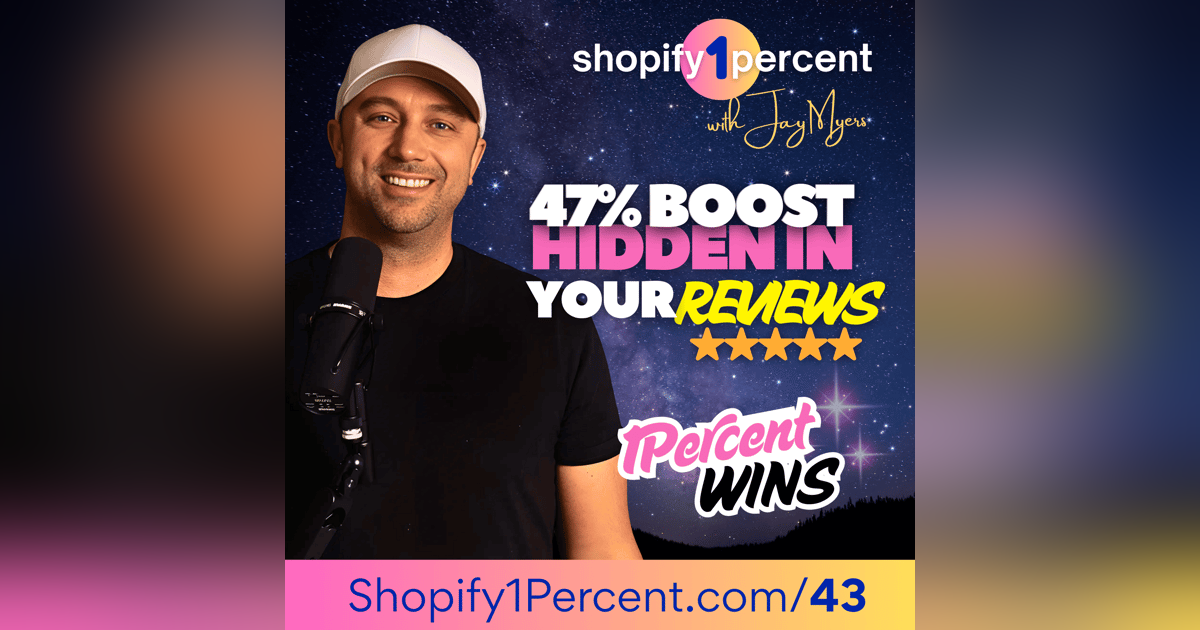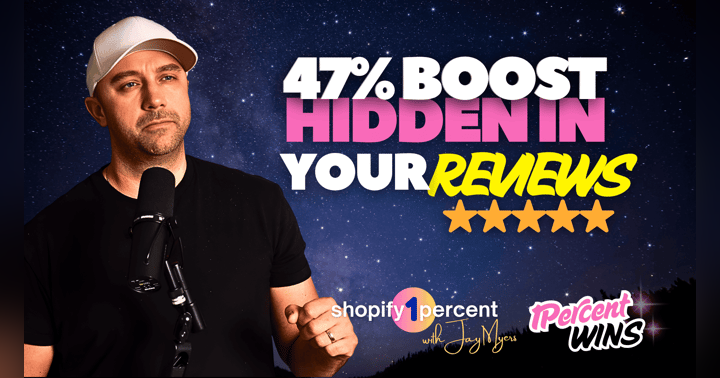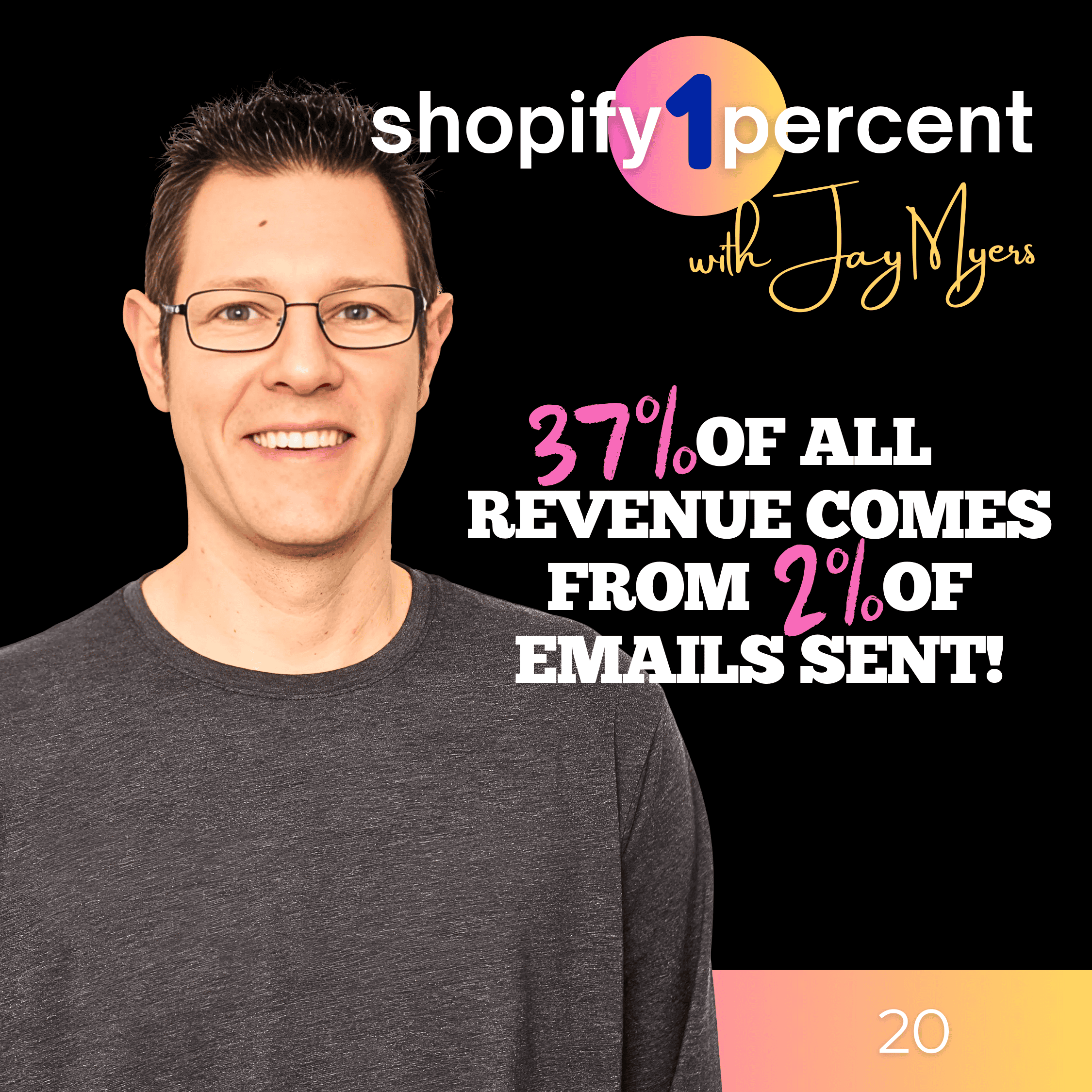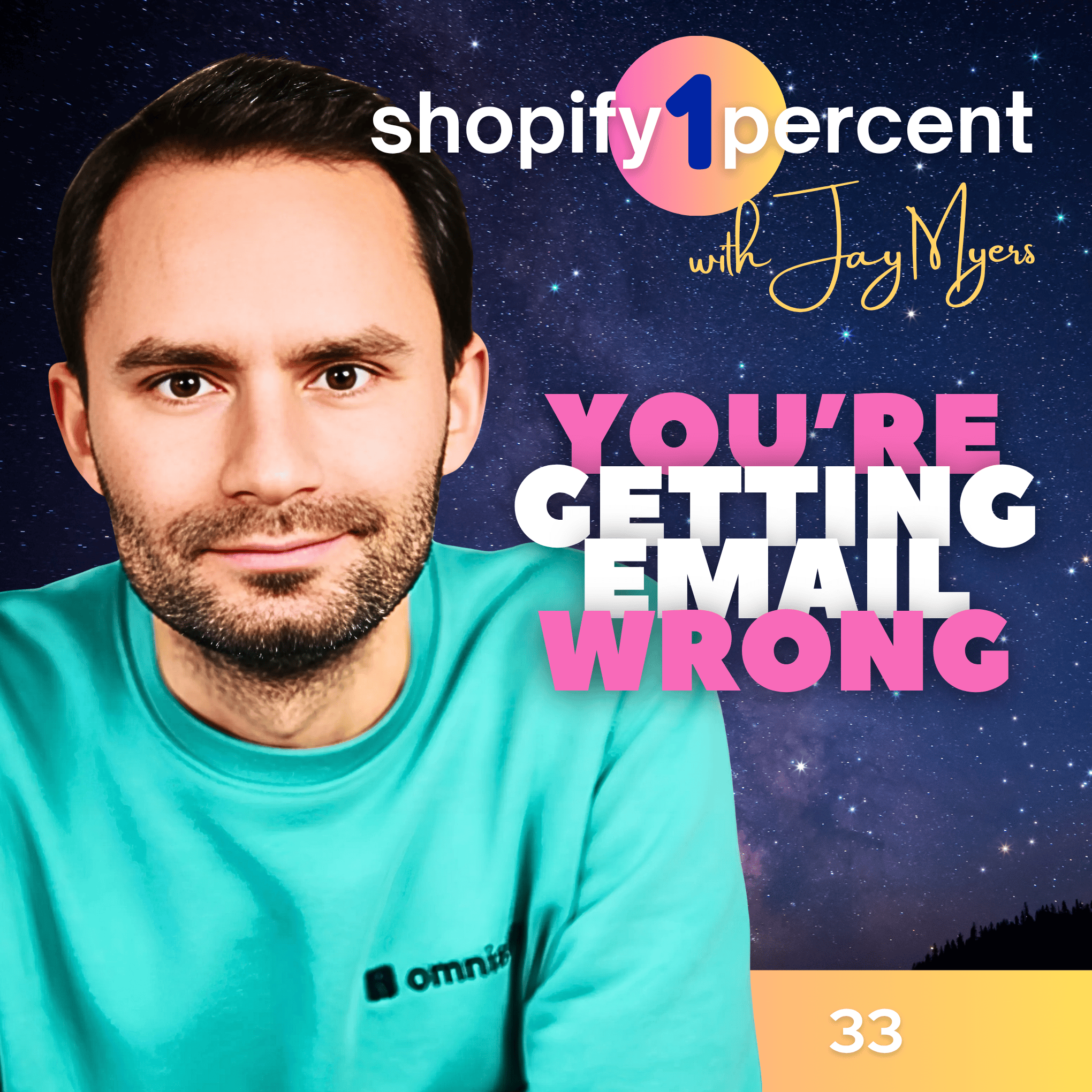🏆 SHOPIFY 1% WINS: The 47% Conversion Secret Hidden in Your Reviews


What if I told you your customers are better copywriters than you are? In this episode, I dig into how using the voice of your customer can increase Shopify conversions by up to 47% (according to MECLABS research). Most brands write copy that talks at customers instead of for them. I’ll show you how to flip that script and turn your homepage into a mirror that instantly builds trust and sells more. If you want to increase sales without spending another dollar on ads, this one’s for you.
Get an exclusive 30% OFF Omnisend for 3 MONTHS: https://shopify1percent.com/omnisend
What if I told you your customers are better copywriters than you are? In this episode, I dig into how using the voice of your customer can increase Shopify conversions by up to 47% (according to MECLABS research). Most brands write copy that talks at customers instead of for them. I’ll show you how to flip that script and turn your homepage into a mirror that instantly builds trust and sells more. If you want to increase sales without spending another dollar on ads, this one’s for you.
Key Take-aways:
🧠 Stop writing like a brand. Customers don’t care what you want to say; they care what they get.
🪞 Your homepage isn’t a brochure—it’s a mirror. Show your customers themselves in your copy.
📈 Using customer language can increase conversions by up to 47%.
🗣️ Harvest real customer words from reviews, support tickets, and social comments.
🤖 Use AI tools like ChatGPT to summarize review patterns and uncover your customers’ true value themes.
💡 Write copy like your best customer just explained your product to a friend—that’s the real secret.
🫶 Support the amazing sponsors that make this show possible 🫶
Omnisend - I personally use Omnisend for every Shopify store I manage! I’ve tried them all and Omnisend is hands down the easiest way to set up email and sms automations and campaigns, leverage segmentation to personalize them, and A/B test everything to optimize conversion. The push notifications and gamified email collection tools are just the icing on the cake 🤌
(plus most report paying about half the price of Klaviyo 🤫)
🚨Listeners (YOU) get an exclusive 30% OFF for 3 MONTHS: https://shopify1percent.com/omnisend
Bold Commerce - Maximize your Shopify sales with Bold's suite of powerful apps. From AI Upselling, to powerful Subscriptions, Memberships, and VIP Pricing tools, Bold has everything you need to Maximize your Shopify revenue!
Try Bold apps for free here: shopify1percent.com/bold
Did you know leaving a ⭐️⭐️⭐️⭐️⭐️ review on Spotify, or Apple will give your shop gooood ecommerce karma? ❤️
Welcome to another Shopify. 1% daily, 1% win. I'm so excited. You're joining me on all these 1% WIN episodes. If you're listening to all of them, you truly are what I call a one percenter. And a one percenter is someone that looks to make 1% improvements every single day. And if you commit to that and you make 1% improvements for a year, at the end of the year, that compounds.
1% compounded over a year grows something 3700%, 37 x. So that's our goal with these 1% wins, quick short episodes to give you something to improve at least 1%. I would say that often it's actually more than 1%. And uh, hey, real quick, if you've got your phone still in your hand
make sure you subscribe to this show so you get notified whenever there is a new episode. We do fun things and sometimes we'll have giveaways. In fact, we're actually giving away t-shirts right now. One percenter shirts. Anyone that leaves a five star review with a comment, you email me, JJAY, at shopify one percent.com and I'll get your size details and send you your shirt that easy.
Let's get into today's 1% win, hands up or just think in your head. If you've ever been designing a page, let's use your homepage as an example.
And you sat there and you thought, okay. What do I wanna say on this page? What message do I want to get across? I've done it, I'm super guilty of it, and we think about our homepage or some type of a landing page. Like the first thought is, okay, what do we want to get across here? Okay, we need some, uh, social proof.
I need some kind of a hook. I need some big tagline, a hero image. But not once does our mind go to. What does the customer want to hear? What does the customer say? And we treat our homepage like it's a big billboard for us. But the truth is no one actually cares about what you want to say. They care about what they get, and they care about what other people say about it.
And if your homepage, if the messaging on your homepage. Doesn't reflect your customer's language, their desires, their interests, their pain points. It is costing you sales. And so what you should be doing when you look at the homepage is actually looking to your customer voice, the voice of your customer, and finding out what they say about your products versus what you want to say.
I'm gonna just break this into kind of two parts here. First why you don't want what you say to be what's on the homepage and why it doesn't work. And here's why. You sitting there thinking about your homepage of like, what do I wanna say? What message do I want to get across?
It doesn't work is for four big reasons. I see. First it's almost always biased and self-serving, and I see this all the time. Merchants write copy that highlight features that they're proud of, but not features that the customers actually care about. They write what they're proud of, their roadmap, their accolades, their awards versus what.
The customers deeply care about and why they buy the product, so it's biased and it's self-serving. That's number one reason why you what you say doesn't work and doesn't matter. Uh, reason number two, is most merchants are too close to their product, you use internal language to describe things. You use jargon, you use acronyms, industry lingo.
That is often the case I see on so many sites is it doesn't impact the person reading it because it's written from someone who is in the health industry or in a certain space and it just doesn't resonate with them and it's meaningless to visitors. And so it's, you're too close to the product.
Number three, customers actually don't read. I know people say this, but like, it's true. Customers won't read all the copy on your website. They'll scan headlines and there's actually been studies done. They scan in a it looks like Z pattern. They go top over, down, diagonally and across.
They read headlines and they scan. So if your headline doesn't immediately reflect their problem in the voice of the customer they'll bounce and often in less than eight seconds. It doesn't take long. And then the last thing is your homepage isn't a brochure, is it's a mirror. And what I mean by this is it shouldn't reflect.
All your features. What, like, what it needs to reflect is what your ideal customer is already thinking and confirm that they're in the right place. They need to see themself in your homepage. They need to instantly, and we've talked about this in other episodes where they need to, well, there, there was the three things they need to feel within the first 60 seconds.
It's, oh my god, that's me. So they understand like that something, some sentiment that you're getting across in the homepage. It's like, yeah, that's me and a second, I'm not alone. So others have this problem too, or others need this product and you can lead me. And so that you're the right person to lead them.
But so your homepage is not a brochure. Stop thinking it of like, oh, here's all the offers, product listings. It's not a brochure, it's a mirror. If the customer can see themself in that homepage, whatever you sell. It could be flowers, it could be medicine, it could be t-shirts it could be just because of like the models you use and the images and the product photos and the language.
But they need to, it's a mirror. They need to be able to see themself in it. Okay? I don't wanna ramble on that one for too long, but your homepage is not a brochure, it's a mirror. Okay? And then that's why, your voice doesn't matter, but here's why. The voice of the customer. Works. First reason it builds instant trust.
When you read something that is in a customer's words, it just feels like you're reading their mind. So like when a customer reads something that is in the way that they would say it, it creates instant connection. How many times have you gone to a website and the, there's some big, fluffy headline.
I dunno, let's just say you sell a coffee maker and the headline is like fostering innovation since 1940, or pursuing excellence in coffee making, or I don't know, like no customer would ever talk about a coffee maker that way. And so it instantly puts up a shield, it removes trust, it puts up a barrier.
But when you use words that they use looking good on every, on counters in America since 1950, helping people wake up since 1942. I dunno, something like this, but words that customers use that creates connection and that creates trust. So number one, it builds instant trust.
Number two, it sharpens your positioning. And if you speak to a specific problem a customer has, versus. That quality and innovation, it really sharpens your position. Like they get it fast. What you're about, what your position is, where you fit in the market of the hundreds of other products are the same.
It's the fastest way to establish positioning is using the voice of the customer. Number three it increases conversions. Actually a study by MEC Labs found that. Brands switching to using exact customer phrasing, increased conversions, 47%. I can put a link to the study in, in the show notes, but essentially brands switched from.
Talking about the products, how they talk about it, to harvesting language from reviews and support tickets and different things and putting it in the customer's word. And they, on average saw a 47% increase in conversion. It's huge. So that's number three. It increases conversion. Number four, is customers uncover what your true differentiators are.
And this kind of as close to sharpening positioning, but your customers can often articulate your unique value better than you can. You've probably had this experience with a friend or someone describing a, I don't know, a skin lotion. A coffee or something, and you ask like, why do you like that?
Well, it just, you know, it doesn't itch right away when I put it on my skin, or it feels better like this. Like they have a, they will articulate it. Better than you ever could. While you're talking about the ingredients and how it's made, they're talking about that one reason they bought it versus a different versus your competitor, because trust me, nobody knows better why they made that decision than the actual customer.
So listening to them. Will help you. Uh, and using that language will help your customers differentiate you from your competitors, like instantly. Okay? So that's why it matters. We talked about why your, your voice doesn't work, why the voice of your customer does work. So what next?
Now what you need to do is harvest the voice of those customers, so. One easy way to do this is what's called review mining. You simply, you can look through all of your reviews and your competitor reviews and highlight things they say about when they found, I found, finally found a product that did this, or I was skeptical at first, but then this, this, this helped me, this lotion really helped me with X or something along those lines.
And note. Anytime there's any kind of emotional language describing how the product made you feel. So like, I was so relieved when I found out this helmet. Has a, a double safety strap so it can't come off or something like this, like the only helmet I feel safe, my kid wearing. Anything like that, you wanna work into your language as well too.
Uh, and we're gonna get into easier ways to harvest 'cause you might have thousands of reviews and using AI is a great way to harvest all of this from that. But the, as far as a place goes, reviews, number one, uh, support tickets and chat logs are. Another great resource and actually something you wanna look for in support tickets is what people are asking before they buy because these can be objections that customers have that you need to address upfront.
If, if you can, depending what you use for your support ticket software, if you can segment out all support tickets before a purchase and. Then load that into chat GPT and ask it to identify the top 10 questions people ask prior to making a purchase. And now create language for landing page copy headlines that addresses those questions.
That's a great way to use support tickets because they're. Literally the, the question isn't answered on your website, so they're messaging you asking for it. So harvest that. Customer survey, customer surveys and post-purchase surveys are another great way, uh, to get this. And actually you know, one of the things that I think a lot of people don't ask is specifically asking the customer.
Why they decided to buy it or what almost stopped them from buying it. People are often too concerned in these post-purchase surveys about, how did you hear about us? Uh, where did you find us? They're, all they're concerned about is their marketing channels and what, what's working, what's not, and what they can double down.
And those are good to have. I'm not saying those are not good questions. You for sure wanna have them, but you wanna find out about the persona of the customer. So I would ask, what problem were you trying to solve? When you found us what problem were you trying to solve by buying this product?
What almost stopped you from buying? Was there any hesitations and if they said, Nope, I had no hesitations, or, well, I was a little bit unsure about this. Okay, then maybe that's something you wanna address. Okay. So, post purchase surveys, I know a lot of people do them, but a lot of people don't ask those questions.
Social media, comments, dms, you know, just. Scanning all the social media posts about your products and seeing how people describe your products, what value do they wish they had? Listen really closely. 'cause sometimes your product has the value, but it's not perceived by the customer. Okay? And I think we've talked about this on other episodes, but there is no such thing as true value.
There's only perceived value I give or take. I mean, some people could argue there's for sure true value, but like value is often, the education process. So like, let's just take a camera. If I don't understand all the features of the camera, I don't perceive the value of like maybe it's got some great defocus mode or some Boca effect or I dunno, something if I don't know how to use that.
Those features I will probably post on social media that like, well the video's great, but the colors don't seem realistic. Well, that's maybe 'cause I haven't learned about it's auto color correcting features or something. So one of the things is when you're listening on social media and you see comments around, I wish I did this, I wish first, make sure that like, if your product does that, if you need to work that into your messaging more, especially in your onboarding series, and educate them.
But b, it might also be a legit feature that you need to build into your product in some way or offer. Um, Amazon and Reddit are a gold mine for language, for voice of the customer. And even if it's not your product, I would look at reviews of exact competitors on Amazon and find out how people are describing it because maybe you don't have thousands of reviews yet.
Maybe you only have 50 reviews. Of course your reviews are the most important, but in general, if you, if you find how people talk about skin lotion that's still helpful. So if you don't have a ton of reviews yet, go to Amazon, find the closest matching product, scrape all the reviews, go through them and find the voice of the customer for that product.
It'll probably be similar and you can of course, tweak. But that is a great starting point. And then what you want to do with all of these is drop them into the AI tool of your choice. Ask it to summarize patterns, ask it to a simple question would be, what are the top five value themes customers mention?
So if you have thousands of reviews, drop them all into chat, GPT and ask it based off all these reviews, what are the top five value themes customers mention? And what that's gonna get you is what they value in your product. Like you might be selling the fact that it's made out of titanium and you the fact that it has a 10 year warranty and the fact that it is indestructible when you drop it or comes with a case like these might be the things that you're promoting, but what you might find out is the customer doesn't value that at all.
What they might find out is that. The battery life is super long. It's longer than any competitor is like, I can recharge the batteries without an external charger. I don't know, but I can almost guarantee what your customer's value is not what you think
they value. But by listening to all of the reviews understanding and then throwing that into ChatGPT and asking it to pull out five value themes, and then putting that as your five sections on your homepage, if you do like a bullets or kind of like a, a ping pong style or however you wanna do it.
It'll increase conversion hands down, guaranteed. Because now you're, now you're speaking to what they actually value. And if you can use the language that they use and if they can see themself, if your homepage becomes a mirror and they can see themself and you're using, not industry jargon, but words they use, and now you're speaking to the values like, holy cow, you are going to just crush conversion.
Okay, so that's it for this one. Summing it up. When you're designing landing pages, email, homepages, copy or anything, don't sit there and think, what do I wanna say? Go out and listen to your customers. Harvest it all, and then use the voice of the customer. Use the values of the customer and work that into whatever copy you write.
Don't write copy like a brand. Write it like your best customer just explained it to a friend. So think about your product, how would your best customer explain it to a friend and that will convert like magic. Okay? That's it for this episode, thanks so much for being a part of these
daily 1% wins if you're getting anything out of them. Please leave a five star review. They mean a ton. We're really trying to get as many as we can, and if you leave a comment with the review, we will feature it on our website and email me directly and I've got an awesome t-shirt to send your way.
Alright, we'll see you on the next episode. Thanks everyone. Take care.


























